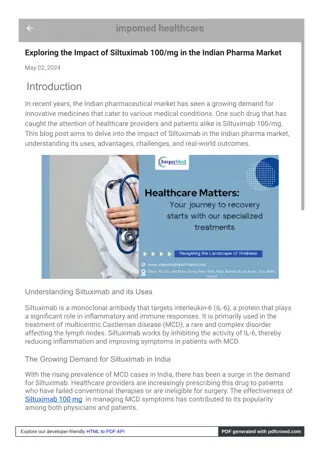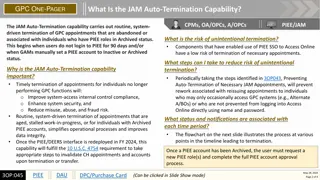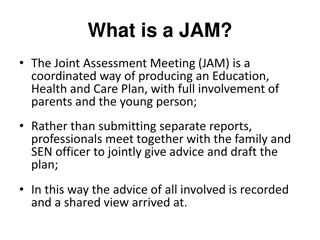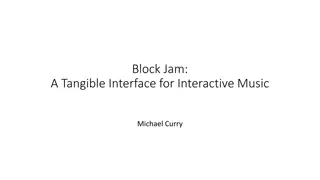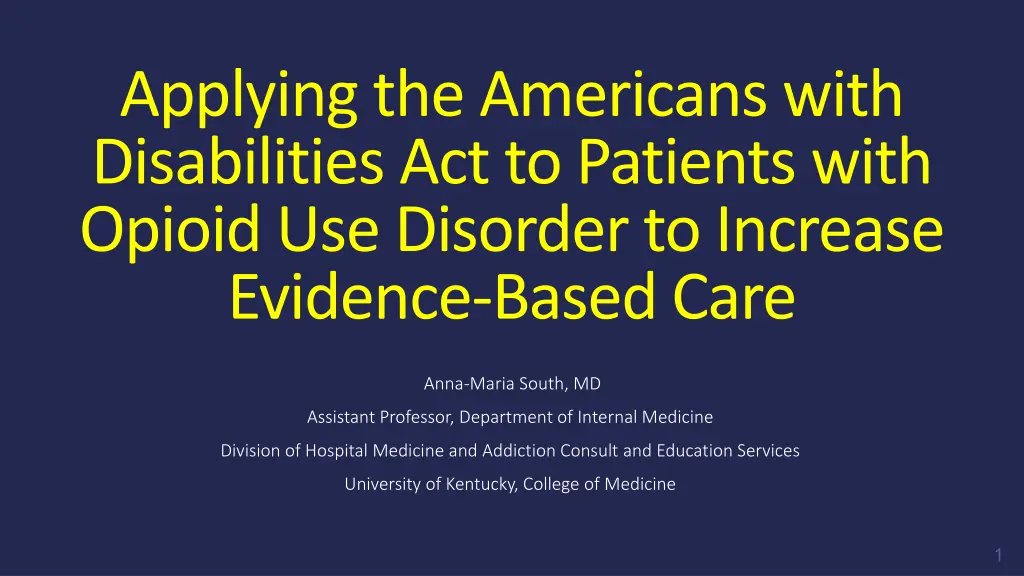
Increasing Evidence-Based Care for Patients with Opioid Use Disorder through ADA Compliance
Explore how to apply the Americans with Disabilities Act (ADA) to enhance evidence-based care for patients with Opioid Use Disorder (OUD). Learn about ADA provisions, advocacy for patients with OUD, and how to ensure compliance with ADA regulations in healthcare settings.
Download Presentation

Please find below an Image/Link to download the presentation.
The content on the website is provided AS IS for your information and personal use only. It may not be sold, licensed, or shared on other websites without obtaining consent from the author. If you encounter any issues during the download, it is possible that the publisher has removed the file from their server.
You are allowed to download the files provided on this website for personal or commercial use, subject to the condition that they are used lawfully. All files are the property of their respective owners.
The content on the website is provided AS IS for your information and personal use only. It may not be sold, licensed, or shared on other websites without obtaining consent from the author.
E N D
Presentation Transcript
Applying the Americans with Disabilities Act to Patients with Opioid Use Disorder to Increase Evidence-Based Care Anna-Maria South, MD Assistant Professor, Department of Internal Medicine Division of Hospital Medicine and Addiction Consult and Education Services University of Kentucky, College of Medicine
Learning Objectives Describe the Americans with Disabilities Act (ADA) Review evidence-based treatment with medications for opioid use disorder (MOUD) Apply the ADA to patients with opioid use disorder (OUD) Discuss practice implications and advocacy tools to ensure you are in compliance with the ADA for patients with OUD
Case 1: A Patient with OUD who needs physical rehab 24-year-old male with OUD on buprenorphine Admitted for acute hypoxic respiratory failure due to COVID-19 Now needs acute rehab for debility after being in the MICU Rehab declines patient due to patient s OUD and being on buprenorphine
Discussion Questions What could you do to advocate for this patient?
Learning Objectives Describe the Americans with Disabilities Act Describe the Americans with Disabilities Act (ADA) (ADA) Review evidence-based treatment with medications for opioid use disorder (MOUD) Apply the ADA to patients with opioid use disorder (OUD) Discuss practice implications and advocacy tools to ensure you are in compliance with the ADA for patients with OUD
The ADA Federal civil rights law (1990) Prohibits discrimination against people with disabilities in every-day activities such as: work transportation housing etc. To be followed by government institutions and public entities Source: U.S. Department of Justice Civil Rights Division. ada.gov
Learning Objectives Describe the Americans with Disabilities Act (ADA) Review evidence Review evidence- -based treatment with based treatment with medications medications for opioid use disorder (MOUD) for opioid use disorder (MOUD) Apply the ADA to patients with opioid use disorder (OUD) Discuss landmark settlements to ensure ADA compliance by public entities
Medications for Opioid Use Disorder (MOUD) Source: Substance Abuse and Mental Health Services Administration. Medications for Opioid Use Disorder. Treatment Improvement Protocol (TIP) Series 63 Publication No. PEP21-02- 01-002. Rockville, MD: Substance Abuse and Mental Health Services Administration, 2021.
Medications for Opioid Use Disorder (MOUD) Methadone Methadone Buprenorphine Buprenorphine Naltrexone Naltrexone Mechanism of Action Benefits for Withdrawal Mortality Benefits FDA Approval for OUD Source: Substance Abuse and Mental Health Services Administration. Medications for Opioid Use Disorder. Treatment Improvement Protocol (TIP) Series 63 Publication No. PEP21- 02-01-002. Rockville, MD: Substance Abuse and Mental Health Services Administration, 2021.
Medications for Opioid Use Disorder (MOUD) Methadone Methadone Buprenorphine Buprenorphine Naltrexone Naltrexone Mechanism of Action Benefits for Withdrawal Full mu receptor agonist Partial mu agonist Mu receptor antagonist Mortality Benefits FDA Approval for OUD Source: Substance Abuse and Mental Health Services Administration. Medications for Opioid Use Disorder. Treatment Improvement Protocol (TIP) Series 63 Publication No. PEP21-02- 01-002. Rockville, MD: Substance Abuse and Mental Health Services Administration, 2021.
Medications for Opioid Use Disorder (MOUD) Methadone Methadone Buprenorphine Buprenorphine Naltrexone Naltrexone Mechanism of Action Benefits for Withdrawal Full mu receptor agonist Treats cravings and withdrawal Partial mu agonist Mu receptor antagonist Does not treat withdrawal, minimal treatment of cravings Mortality Benefits FDA Approval for OUD Source: Substance Abuse and Mental Health Services Administration. Medications for Opioid Use Disorder. Treatment Improvement Protocol (TIP) Series 63 Publication No. PEP21-02- 01-002. Rockville, MD: Substance Abuse and Mental Health Services Administration, 2021.
Medications for Opioid Use Disorder (MOUD) Methadone Methadone Buprenorphine Buprenorphine Naltrexone Naltrexone Mechanism of Action Benefits for Withdrawal Full mu receptor agonist Treats cravings and withdrawal Partial mu agonist Mu receptor antagonist Does not treat withdrawal, minimal treatment of cravings Has not been proven to reduce all cause mortality Mortality Benefits Reduce all cause mortality Reduce opioid-overdose mortality FDA Approval for OUD Source: Substance Abuse and Mental Health Services Administration. Medications for Opioid Use Disorder. Treatment Improvement Protocol (TIP) Series 63 Publication No. PEP21-02-01- 002. Rockville, MD: Substance Abuse and Mental Health Services Administration, 2021.
Medications for Opioid Use Disorder (MOUD) Methadone Methadone Buprenorphine Buprenorphine Naltrexone Naltrexone Mechanism of Action Benefits for Withdrawal Full mu receptor agonist Treats cravings and withdrawal Partial mu agonist Mu receptor antagonist Does not treat withdrawal, minimal treatment of cravings Has not been proven to reduce all cause mortality Relapse Prevention Mortality Benefits Reduce all cause mortality Reduce opioid-overdose mortality FDA Approval for OUD Treatment of OUD Source: Substance Abuse and Mental Health Services Administration. Medications for Opioid Use Disorder. Treatment Improvement Protocol (TIP) Series 63 Publication No. PEP21-02- 01-002. Rockville, MD: Substance Abuse and Mental Health Services Administration, 2021.
Addressing the Opioid Overdose Crisis: MOUD Must Must Be Part of the Solution Dupouy J. et al Mortality Associated With Time In and Out of Buprenorphine Treatment in French Office-Based General Practice: A 7-year Cohort Study. Ann. Fam. Med. 2017. 15(4): 355-358. Evans E. et al Mortality Among Individuals Accessing Pharmacological Treatment for Opioid Use Disorder in California, 2006-2010. Addiction. 2015. 110 (6): 996-1005. Sordo L. et al Mortality Risk During and After Opioid Substitution Treatment: Systemic Review and Meta-Analysis of Cohort Studies. BMJ. 2017. 357:j1550.
Learning Objectives Describe the Americans with Disabilities Act (ADA) Review evidence-based treatment with medications for opioid use disorder (MOUD) Apply the ADA to patients with opioid use disorder Apply the ADA to patients with opioid use disorder (OUD) (OUD) Discuss landmark settlements to ensure ADA compliance by public entities
The ADA for Patients with OUD OUD can substantially limit one or more major life activities Individuals with OUD qualify for protection under the ADA Withholding medication for opioid use disorder (MOUD) as a policy, not due to individualized medical assessment = potential ADA violation Discontinuation of MOUD as a policy = ADA violation Public entitynotallowed to withhold medical services due to substance use Source: The United States Department of Justice. Civil Rights Division. The Americans with Disabilities Act and Opioid Crisis: Combating Discrimination Against People in Treatment or Recovery. April 5, 2022
Department of Justice (DOJ) Guidance for the ADA for Patients with OUD People with OUD have a disability The ADA protects individuals With OUD who take legally prescribed medication for OUD, such as MOUD With OUD who participate in a substance use treatment program With a history of past OUD who no longer use illegal substances Source: The United States Department of Justice. Civil Rights Division. The Americans with Disabilities Act and Opioid Crisis: Combating Discrimination Against People in Treatment or Recovery. April 5, 2022
Practical Implications Which of the following is NOT A. A city terminates an employee because they are on MOUD B. A hospital refuses to employ a physician because of their history of OUD after they disclose completion of residential treatment C. A nursing home refuses to hire a nursing aid because their urine drug screen was positive for fentanyl that was not prescribed by a physician D. A public library terminates an employee for taking oxycodone prescribed to them for chronic back pain NOT a potential ADA violation?
Practical Implications Which of the following is NOT A. A city terminates an employee because they are on MOUD B. A hospital refuses to employ a physician because the of their history of OUD after the disclose completion of residential treatment C. C. A nursing home refuses to hire a nursing aid because their A nursing home refuses to hire a nursing aid because their urine drug screen was positive for fentanyl that was not urine drug screen was positive for fentanyl that was not prescribed by a physician prescribed by a physician D. A public library terminates an employee for taking oxycodone for chronic back pain NOT a potential ADA violation?
Learning Objectives Describe the Americans with Disabilities Act (ADA) Review evidence-based treatment with medications for opioid use disorder (MOUD) Apply the ADA to patients with opioid use disorder (OUD) Discuss landmark settlements to ensure ADA compliance by Discuss landmark settlements to ensure ADA compliance by public entities public entities
Case 1: A Patient with OUD who needs physical rehab 24-year-old male with OUD on buprenorphine Admitted for acute hypoxic respiratory failure due to COVID-19 Now needs acute rehab for debility after being in the MICU Rehab declines patient due to patient OUD and being on buprenorphine
Case 1: A Patient with OUD who needs physical rehab (cont) Settlement Agreement under the ADA SNIF cannot screen out an individual/a group of individuals (patients with OUD) from receiving health care services Sample letter: https://www.lac.org/assets/files/Advocacy-Guide_v4-w-attach-a.pdf Source: Operator of 21 Massachusetts Skilled Nursing Facilities Agrees to Resolve Allegations of Disability Discrimination. United States Attorney s Office. https://www.justice.gov/usao-ma/pr/operator-21-massachusetts-skilled-nursing-facilities-agrees-resolve-allegations
Case 2: A Patient with CF and OUD 28-year-old male with cystic fibrosis in need of lung transplant Has OUD due to being prescribed opioids as a child On buprenorphine for treatment for OUD Participates in continued counseling program for OUD Transplant evaluation declined due to patient s OUD
Group Discussion Questions Discuss with your group for 5 min and be prepared to share: Does the decision by transplant to deny evaluation seem just? What is justice in medical ethics? Is this a potential ADA violation? What could you do to advocate for this patient if you were his doctor?
Case 2: A Patient with CF and OUD (cont) Settlement Agreement under the ADA (2020) Hospital cannot screen out an individual/a group of individuals (patients with OUD) from receiving health care services Hospital required to provide ADA training to all staff Monetary settlement paid to patient and patient s mother Source: Settlement Agreement between the United States of America and Massachusetts General Hospital under the American with Disabilities Act https://archive.ada.gov/mass_gen_hosp_sa.html
Previous Group Discussion Questions Does the decision by transplant to deny evaluation seem just? What is justice in medical ethics? No. The patient is being discriminated against based on having a disability and a chronic medical condition Medical Justice: No patient is unfairly disadvantaged in accessing health care Is this a potential ADA violation? Yes. The settlement explains this. What could you do to advocate for this patient if you were his doctor? Educate the patient and other providers about the ADA to ensure compliance and file a complaint with e.g., assistant US attorney, so it can be investigated to determine if it is an ADA violation
Case 3: A Patient with OUD Seeking Care for Post-Traumatic Stress Disorder (PTSD) You have a patient with OUD on buprenorphine is seeking treatment for PTSD Refer patient to psychiatrist for management Calls outpatient psychiatry clinic to make an appointment Clinic demands for patient to be off MOUD for several months to establish care for PTSD
Discussion Questions Is this an ADA violation and why/why not? What avenues of advocacy can you think of for the patient to use?
Case 3: A Patient with OUD Seeking Care for PTSD (cont.) - Settlement Cannot withhold medical care for patients for being on MOUD If lacking expertise to treat condition due to OUD: Do not have to treat OUD, but refer to a provider who can Clinic to provide nondiscriminatory care for patients with OUD and ensure compliance with the ADA Source: United States Department of Justice. https://www.justice.gov/usao-edky/pr/us-attorney-s-office-reaches-settlement-ashland-based-hospital-resolving-alleged
Avenues for Advocacy for Patients and Physicians ADA.gov civilrights.justice.gov Contact assistant U.S. attorney for the district where the possible violation occurred (U.S. Attorneys | Find Your United States Attorney | United States Department of Justice) Nonprofit organizations (i.e. Legal Action Center, American Civil Liberties Union) Private attorney (patient)
How to File a Potential ADA violation Ensure violation based on a policy, not on an individualize d medical assessment A Document details (e.g., conversations, emails) and provide them when submitting a case Submit a case for investigation of a potential ADA violation possible ADA violation occurs for a patient with OUD
How to File a Potential ADA violation Ensure that either: Patient signs release of information form OR de-identify data to be compliant with Health Insurance Portability and Accountability Act (HIPAA) Optional: Discuss violation with the patient (patient can also file on their own behalf the more complaints received, the more information that the assistant US attorney will have) Be available for assistant US attorney for follow up
Case 4: Incarcerated Patient with OUD and Infection Hospitalized for injection related infection Receives appropriate medical management for his infection Desires buprenorphine to treat OUD Guards at bedside interrupt buprenorphine administration: You know he can t have this in jail, right?
Discussion Questions What are some complicating factors for this patient? Does the ADA still apply? How can you advocate for this patient?
Discussion Questions What are some complicating factors for this patient? Barriers to treatment as carceral system is interfering with medical care Does the ADA still apply? Yes. Incarcerated patients with OUD on MOUD are still protected by the ADA How can you advocate for this patient? Barriers require multistep approach
The ADA for Incarcerated Patients on MOUD DOJ: Discontinuation of MOUD = ADA violation Pesce vs Coppinger (Massachusetts 2018), DiPerro v Hurwitz (Massachusetts 2019), Crews v. Sawyer (Kansas 2019), Godsey v Sawyer (District of Washington 2019) Agreement between the United States of America and Lexington- Fayette Urban County Government Division of Community Corrections Not all jails or prisons are currently compliant with the ADA Not all jails or prisons are currently compliant with the ADA Continued advocacy is needed Continued advocacy is needed Source: Legal Action Center https://www.lac.org/assets/files/Cases-involving-denial-of-access-to-MOUD.pdf
Pennsylvania ADA settlement Settlement between the DOJ and courts in multiple counties in PA (the Supreme Court of Pennsylvania, and the Blair, Jefferson, Lackawanna and Northumberland County Courts of Common Pleas) People were forced to stop their MOUD to participate in court supervision programs https://www.justice.gov/d9/2024-01/settlement_agreement- u.s._v._the_unified_judicial_system_of_pennsylvania.pdf
Considerations when filing ADA violation Not individual provider that is investigated but public entity Assistant US attorney represents the United States Monetary settlements are often smaller amounts Goal: To ensure public entities are compliant with ADA
Additional Resources Cohen S, Joab R, Bolles K et al Ending Medical Complicity With Skilled-Nursing Facility Discrimination Against People With Opioid Use Disorder. Annals of Internal Medicine. 2023 Legal Action Center. A Guide to Hospitals' Legal Obligations for ED Patients with Substance UseRelated Conditions. https://www.lac.org/assets/files/Hospital-Administrator-Guide_v3.pdf Accessed on 6/21/2024 Legal Action Center. Cases Involving Discrimination Based on Treatment with Medication for Opioid Use Disorder (MOUD). Available at Cases-involving-denial-of-access-to-MOUD.pdf (lac.org) Accessed on 6/21/2024. 38. Legal Action Center. Landau v. Good Samaritan Hospital et al. Legal Action Center | Landau v. Good Samaritan Hospital et al. Accessed on 6/21/2024 South AM, Fanucchi LC, Lofwall MR. Advocacy for patients with opioid use disorder: A primer for physicians and other clinicians on the Americans with Disabilities Act. Journal of Opioid Management. 2023. 19(7), 53 60. South AM, Fanucchi L, Lofwall M. Treating Opioid Use Disorder in Patients Who Are Incarcerated: Quandaries of a Hospitalist. JAMA. 2023 May 23;329(20):1738-1739. doi: 10.1001/jama.2023.5904. PMID: 37093586. U.S. Department of Justice Civil Rights Division. The Americans with Disabilities Act and the Opioid Crisis: Combating Discrimination Against People in Treatment or Recovery Available at https://archive.ada.gov/opioid_guidance.pdf Accessed on 10/3/2024
Acknowledgements Supported by the Bell Addiction Medicine Scholar Program at the University of Kentucky (Chair: Michelle Lofwall, MD, DFASAM, DFAPA) The UK Addiction Consult and Education Service is funded by the Kentucky Opioid Response Effort funded by the Substance Abuse and Mental Health Services Administrations (H79TI080264) and State Opioid Response (H79TI081704) grants (PI: Laura Fanucchi, MD, MPH, FASAM) Supported by the Academic Medicine Writing Fellowship by Building the Next Generation of Academic Physicians (BNGAP) National Center for Pre-Faculty Development and National Center for LMSA Leadership and Advancement
Contact information Anna-Maria South, MD aso248@uky.edu
Sources 1. Dupouy J, Palmaro A, Fatseas M et al.: Mortality associated with time in and out of buprenorphine treatment in french office-based general practice: A 7-year cohort study. Ann Fam Med. 2017; 15(4): 355-358. Earnest, M, Wong, S, Federico S:Perspective: Physician Advocacy: What is it and how do we do it? Academic Medicine. 2010. 85(1): 63-67 Eber GB Using the Constitution to Improve Prisoner Health. Am J Public Health. 2009. 99(9). 1541-1542. Evans E, Libo L, Min J et al.: Mortality among individuals accessing pharmacological treatment for opioid depedence in California, 2006-2010. Addiction. 2015; 110(6): 996-1005. Legal Action Center. Cases involving discrimination based on treatment with medication for Opioid Use Disorder (MOUD) June 6, 2022. Available at https://www.lac.org/assets/files/Cases-involving-denial-of-access-to-MOUD.pdf Accessed November 16, 2022. National Center on Drug Abuse. Overdose death rates. Available at https://nida.nih.gov/research-topics/trends-statistics/overdose-death-rates Accessed December 28,2022. Sordo L, Barrio G, Bravo MJ et al.: Mortality risk during and after opioid substitution treatment: Systemic review and meta-analysis of cohort studies. BMJ. 2017; 357:j1550. Substance Abuse and Mental Health Services Administration. Medications for Opioid Use Disorder. Treatment Improvement Protocol (TIP) Series 63 Publication No. PEP21-02-01-002. Rockville, MD: Substance Abuse and Mental Health Services Administration, 2021. The United States Department of Justice. Memorandum of agreement between the United States of America and Lexington-Fayette Urban County Government Division of Community Corrections. Available at https://www.justice.gov/crt/case-document/file/1551136/download Accessed December 20, 2022. The United States Department of Justice. Settlement agreement between the United States of America and Ashland Hospital Corporation D/B/A King s Daughter s Medical Center. Under the Americans with Disabilities Act. Available at https://www.justice.gov/crt/case- document/file/1547661/download Accessed December 20, 2022. The United States Department of Justice. Settlement agreement between the United States of America and Massachusetts General Hospital under the American with Disabilities Act. Available at https://archive.ada.gov/mass_gen_hosp_sa.html Accessed November 16, 2022. U.S. Constitution. Amend. XIV. Available at https://constitutioncenter.org/the-constitution/amendments/amendment-xiv Accessed November 16, 2022. U.S. Department of Justice Right Division: Introduction to the Americans with Disabilities Act. Available at https://www.ada.gov/topics/intro-to- ada/ Accessed November 16, 2022. U.S. Department of Justice Right Division: The Americans with Disabilities Act and the opioid crisis: Combating discrimination against people in treatment or recovery. Available at https://archive.ada.gov/opioid_guidance.pdf Accessed December 20, 2022. 2. 3. 4. 5. 6. 7. 8. 9. 10. 11. 12. 13. 14.






